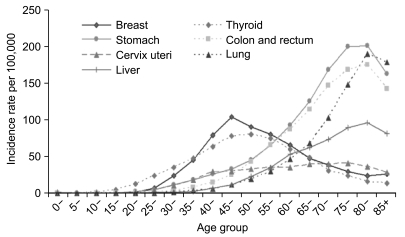Cancer Res Treat.
2009 Sep;41(3):122-131.
Nationwide Cancer Incidence in Korea, 2003-2005
- Affiliations
-
- 1The Korea Central Cancer Registry, National Cancer Center, Goyang, Korea. jsung@snu.ac.kr, canreg@ncc.re.kr
- 2School of Public Health, Seoul National University, Seoul, Korea.
- 3International Agency for Research on Cancer, Lyon, France.
- 4National Cancer Control Research Institute, National Cancer Center, Goyang, Korea.
- 5Seoul Cancer Registry, Seoul, Korea.
- 6Busan Cancer Registry, Busan, Korea.
- 7Daegu Cancer Regisry, Daegu, Korea.
- 8Gwangju Cancer Registry, Gwangju, Korea.
- 9Incheon Cancer Registry, Incheon, Korea.
- 10Daejeon Cancer Registry, Daejeon, Korea.
- 11Ulsan Cancer Registry, Ulsan, Korea.
- 12Jeju-do Cancer Registry, Jeju, Korea.
- 13Korean Medical Record Association, Seoul, Korea.
- 14Health Insurance Policy Research Institute, National Health Insurance Corporation, Seoul, Korea.
- 15Ministry for Health, Welfare and Family Affairs, Seoul, Korea.
Abstract
- PURPOSE
To estimate the current cancer burden in Korea, newly diagnosed cancer cases and cancer incidence rates were calculated for the years 2003~2005. MATERIALS AND METHODS: The cancer incidence cases and rates were calculated from the Korea National Cancer Incidence Database. Crude and age-standardized incidence rates were calculated by gender for specified cancer sites in 5-year age groups. RESULTS: From 2003 to 2005, 398,824 cases of cancer were newly diagnosed in Korea (218,856 in men and 179,968 in women). For all sites combined, the crude incidence rate (CR) was 300.0 and 248.2 for men and women and the age-standardized incidence rate (ASR) was 297.0 and 191.2 per 100,000, respectively. Among men, five leading cancers were stomach (CR 66.0, ASR 64.2), lung (CR 48.5, ASR 50.3), liver (CR 44.9, ASR 42.1), colon and rectum (CR 37.9, ASR 37.2), and prostate cancer (CR 12.7, ASR 13.8). Among women, five leading cancers were breast (CR 37.3, ASR 29.0), thyroid (CR 36.2, ASR 28.8), stomach (CR 34.1, ASR 25.4), colon and rectum (CR 28.0, ASR 21.1), and lung cancer (CR 17.9, ASR 12.8). In the 0~14-year-old group, leukemia was the most common in both sexes; in the 15~34 group, the most common cancer was stomach cancer for men and thyroid cancer for women; in the 35~64 group, stomach cancer for men and breast cancer for women; among those 65 and over, lung cancer for men and stomach cancer, for women, respectively. CONCLUSION: The cancer incidence rates have increased in recent years, and more cancers are expected to develop as Korea is quickly becoming an aged society. The cancer incidence statistics in this report can be used as an important source to effectively plan and evaluate the cancer control program in Korea.
Keyword
MeSH Terms
Figure
Reference
-
1. World Health Organization. National Cancer Control Programmes. Policies and Managerial Guidelines. 2002. 2nd ed. Geneva: World Health Organization.2. Shin HR, Won YJ, Jung KW, Kong HJ, Yim SH, Lee JK, et al. Nationwide cancer incidence in Korea, 1999~2001: first result using the National Cancer Incidence Database. Cancer Res Treat. 2005; 37:325–331.
Article3. Shin HR, Jung KW, Won YJ, Yim SH, Sung JH, Seo SW, et al. National Cancer Incidence for the Year 2002 in Korea. Cancer Res Treat. 2007; 39:139–149. PMID: 19746208.
Article4. Fritz A, Percy C, Jack A, Shanmugaratnam K, Sobin L, Parkin DM, et al. International Classification of Disease for Oncology. 2000. 3rd ed. Geneva: World Health Organization.5. Manual of the International Statistical Classification of Diseases, Injuries, and Causes of Death, 10th revision. 1992. Geneva: World Health Organization.6. Working Group Report. International Rules for Multiple Primary Cancers (ICD-O, 3rd ed.). Eur J Cancer Prev. 2005; 14:307–308. PMID: 16030420.7. Segi M. Cancer Mortality for Selected Sites in 24 Countries (1950~1957). 1960. Sendai: Tohoku University School of Medicine.8. Korean Statistical Information System. Korea National Statistical Office. Available at URL: http://kosis.nso.go.kr.9. Skeet RG. Jensen OM, Parkin DM, MacLennan R, Muir CS, Skeet RG, editors. Quality and quality control. Cancer Registration Principles and Methods. 1991. Lyon: IARC;p. 101–107.10. Shin HR, Won YJ, Jung KW, Park JG, Hong EK, Suh CI, et al. Curado MP, Edwards B, Shin HR, Storm H, Ferlay J, Heanue M, editors. Cancer incidence in Korea (1999~2002). Cancer Incidence in Five Continents. 2007. Vol. IX. Lyon: IARC.11. Davies L, Welch HG. Increasing incidence of thyroid cancer in the United States, 1973~2002. JAMA. 2006; 295(18):2164–2167. PMID: 16684987.
Article12. Parkin DM, Bray F. Evaluation of data quality in the cancer registry: principles and methods. Part II. Completeness. Eur J Cancer. 2009; 45:755–764.
Article13. Ajiki W, Tsukuma H, Oshima A. Index for evaluating completeness of registration in population-based cancer registries and estimation of registration rate at the Osaka Cancer Registry between 1966 and 1992 using this index. Nippon Koshu Eisei Zasshi. 1998; 45:1011–1017. PMID: 9893469.14. North AB, South CD. Curado MP, Edwards B, Shin HR, Storm H, Ferlay J, Heanue M, editors. Cancer incidence in Antartica (1998~2002). Cancer Incidence in Five Continents. 2007. Vol. IX. Lyon: IARC;IARC Scientific Publications IV. 160.
- Full Text Links
- Actions
-
Cited
- CITED
-
- Close
- Share
- Similar articles
-
- Methods for Estimation of Nationwide Cancer Incidence from Population-based Cancer Registries
- Cancer Statistics in Korea: Incidence, Mortality and Survival in 2005
- Incidence and Treatment Pattern of Extremity Soft Tissue Sarcoma in Korea, 2009-2011: A Nationwide Study Based on the Health Insurance Review and Assessment Service Database
- Relationship Between Appendectomy Incidence and Computed Tomography Scans Based on Korean Nationwide Data, 2003–2017
- Nationwide Trends in the Incidence of Melanoma and Non-melanoma Skin Cancers from 1999 to 2014 in South Korea



